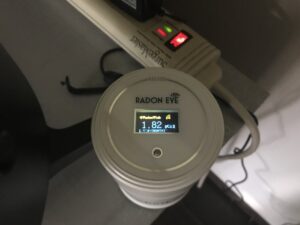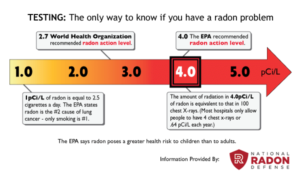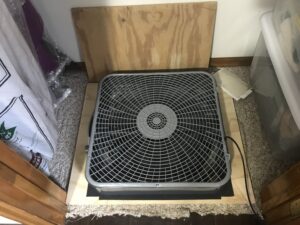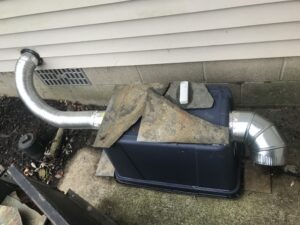Radon Mitigation is a big deal in Ohio, although something I never heard of when I was a kid. It turns out that the glaciers cutting across Ohio 280 million years ago, deposited uranium and radium in the soil. Because of this, the Ohio Shale Formation contains quantities of uranium and radium, both of which continuously break down and release radon gas. This means, Ohio’s geology provides a continuous supply of radon. And radon gas is the #1 cause of lung cancer in non-smokers.
Now, part of the reason it wasn’t such a big deal 50 years ago is that houses were not airtight. We know that older houses were drafty and had cold spots in them in the winter. Those drafts meant that any radon gas in the house would dissipate. Also, people opened windows and used screens in the summer. With the advent of air-conditioning, houses have become more energy-efficient, which also means they are built tighter. So they hold the radon gas inside the house.
 When we had our house inspected, we had it tested for radon. And we found that our radon levels were unacceptably high. The sellers refused to do any radon mitigation, so we made the choice to buy the house anyway. The average cost for radon mitigation is $1,500. Hefty, but not exorbitant. What we didn’t realize is that our house, sitting on an unfinished crawl space, quadrupled the price of radon mitigation. None of the radon people want to deal with an unfinished crawl space. First you have to encapsulate the crawl space with a moisture proof barrier, then you have to do the radon mitigation.
When we had our house inspected, we had it tested for radon. And we found that our radon levels were unacceptably high. The sellers refused to do any radon mitigation, so we made the choice to buy the house anyway. The average cost for radon mitigation is $1,500. Hefty, but not exorbitant. What we didn’t realize is that our house, sitting on an unfinished crawl space, quadrupled the price of radon mitigation. None of the radon people want to deal with an unfinished crawl space. First you have to encapsulate the crawl space with a moisture proof barrier, then you have to do the radon mitigation.
Tom has been researching and thinking about the problem since we moved in. We don’t want to die of lung cancer, but we also don’t want to spend in excess of $6,000 to get rid of the radon. We have utilities in the crawl space that we need access to, which we would not have if the crawl space was encapsulated.
 Our first step to fixing the problem was getting a radon monitor. We set it up in the living room, which is the center of the house. It connects to the Wi-Fi, and Tom has an app on his phone that takes and stores data points every 30 minutes. We found that during the summer and early fall, the radon levels were between 4 and 12. A radon level of 1 is the equivalent to smoking 2.5 cigarettes a day. The World Health Organization recommends radon levels below 2.7, and the Environmental Protection Agency says anything over 4 requires action. Obviously our radon levels were problematic.
Our first step to fixing the problem was getting a radon monitor. We set it up in the living room, which is the center of the house. It connects to the Wi-Fi, and Tom has an app on his phone that takes and stores data points every 30 minutes. We found that during the summer and early fall, the radon levels were between 4 and 12. A radon level of 1 is the equivalent to smoking 2.5 cigarettes a day. The World Health Organization recommends radon levels below 2.7, and the Environmental Protection Agency says anything over 4 requires action. Obviously our radon levels were problematic.
Air exchange is the solution to the radon problem. Get the bad air out of the house and bring in good, outside air. Tom started by putting an old box fan that we had over the crawl space opening. The box fan blew air into the crawl space and, hopefully, kept it from coming up into the house. This was a very cheap solution that helped immediately. Our radon levels decreased to between 1 and 4. Much safer, but still a little high. The radon levels especially increase at night and increase even more when the furnace is on.

Tom kept researching air exchange rates and fan sizes. He decided we needed a fan pulling air from the crawl space to the outside. Fortunately the crawl space had a vent that used to be the dryer vent. Using some vent pipe, an industrial vent fan, and (of course) some duct tape, Tom installed a fan to pull air from the crawl space. So the box fan at the opening pushed air into the crawl space and the vent fan outside pulled air out of the crawl space. And our radon levels went down even further.

Tom finished the project by “professionalizing” the appearance of the fans. He cut a board to hold a new box fan over the crawl space opening. He added some foam insulation that lessens the noise of the fan and put a grate in the closet door so it is out of sight. Outside, he put the vent fan in a weather-proof container and added sound insulation to keep it quieter.
Now our radon levels are usually between 1 and 2. On very cold days, when the furnace runs a lot, they can rise to 2.5, but much safer than we started with. Tom thinks that if we close the furnace vent in the crawl space, the levels will stay lower and more constant.
I never thought I would know this much about radon, but living in this house has been an education. Tom has done a great job problem-solving with it and we think this is a solution we can live with. And the total cost, including the radon monitor, was about $500.
